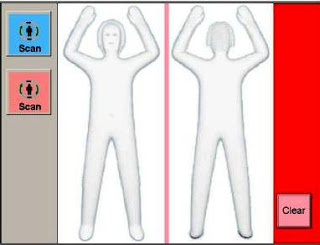***Updated 2/2/2011 to upload image showing alarms.***
I can remember the first time we blogged about Advanced Imaging Technology (AIT). It was referred to as Whole Body Imaging back then, and is now more commonly referred to by the flying public as a “Body Scanner” as well as a few other clever but inaccurate monikers.
Anyway, ever since we first started talking about them, a small percentage of travelers have had privacy concerns with the AIT machines, and we have addressed those concerns in a variety of ways. TSA has implemented strict measures to protect passenger privacy, which is ensured through the anonymity of the image. A remotely located officer views the image and does not see the passenger, and the officer assisting the passenger cannot view the image. The image cannot be stored, transmitted or printed, and is deleted immediately once viewed. Additionally, there is a privacy algorithm applied to blur the image.
We are always looking for new technology and procedures that will both enhance security while strengthening privacy protections. That’s why we worked with the Department of Homeland Security’s (DHS) Science & Technology Directorate (S&T) and private industry to develop the software, and began testing in labs in Fall of 2010.
The software will be tested at Las Vegas McCarran International Airport (LAS) starting today, February 1, and at Hartsfield Jackson Atlanta International (ATL) and Ronald Reagan Washington National Airport (DCA) in the very near future.
So if you’re scratching your head at this point and asking, “What in the heck does this software do?”, it works with our AIT machines and eliminates passenger-specific images and replaces them with the generic outline of a person (see image below).
Here’s how it works: You step into the AIT machine and the new software will automatically detect potential threats and show their location on a generic image of a person. The image is on a monitor that is attached to the AIT unit in public view. Because this eliminates privacy concerns, we no longer have to staff an officer in a separate room.
If there are areas that need to be searched, the monitor will display this image.

If there are areas that need to be searched, the monitor will display this image.
If there are no potential threats, there will be no image and the monitor will look like this.
Blogger Bob
TSA Blog Team
If you’d like to comment on an unrelated topic you can do so in our Off Topic Comments post. You can also view our blog post archives or search our blog to find a related topic to comment in. If you have a travel related issue or question that needs an immediate answer, you can contact a Customer Support Manager at the airport you traveled, or will be traveling through by using Talk to TSA.

